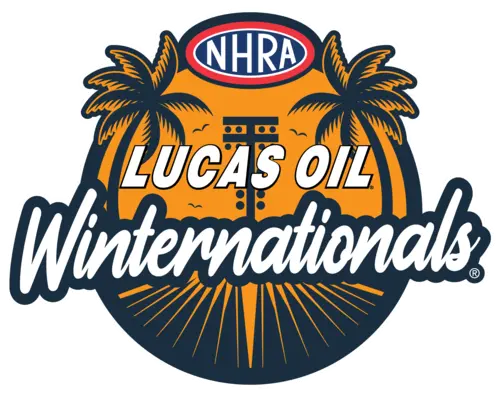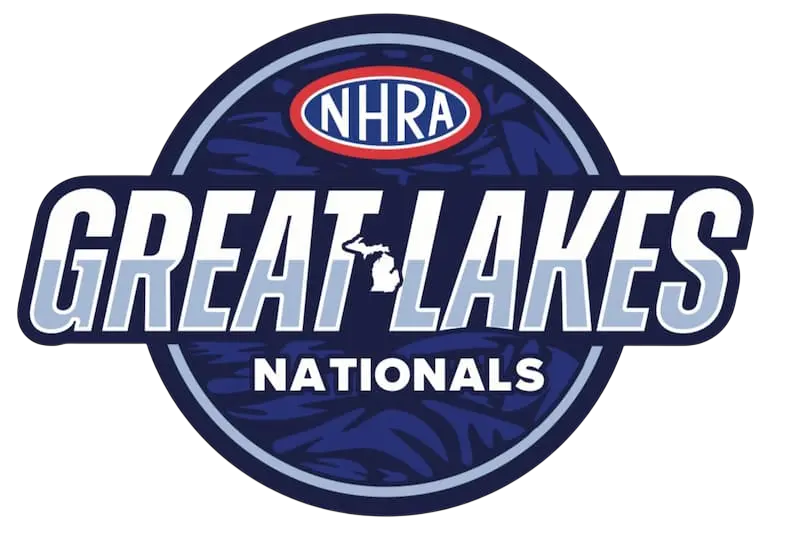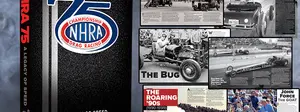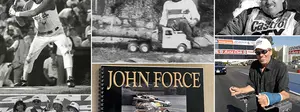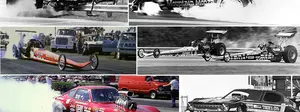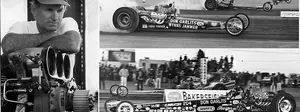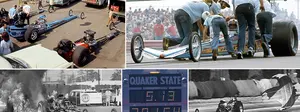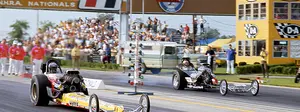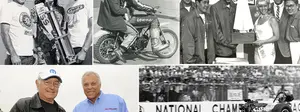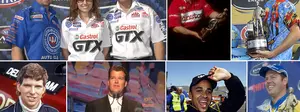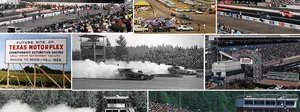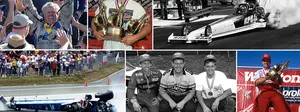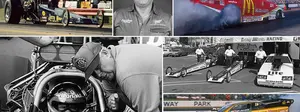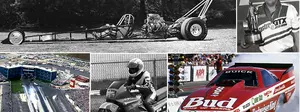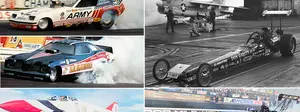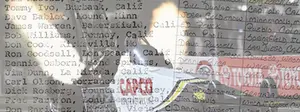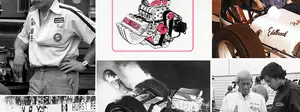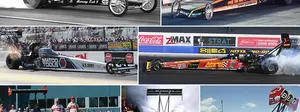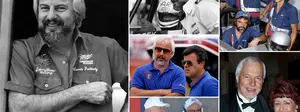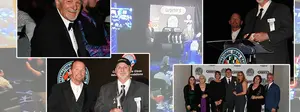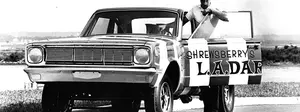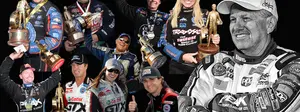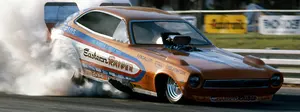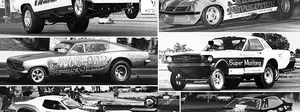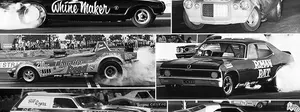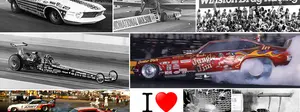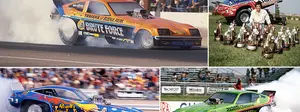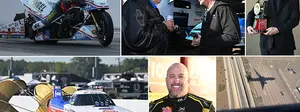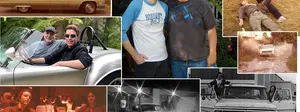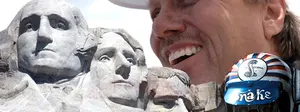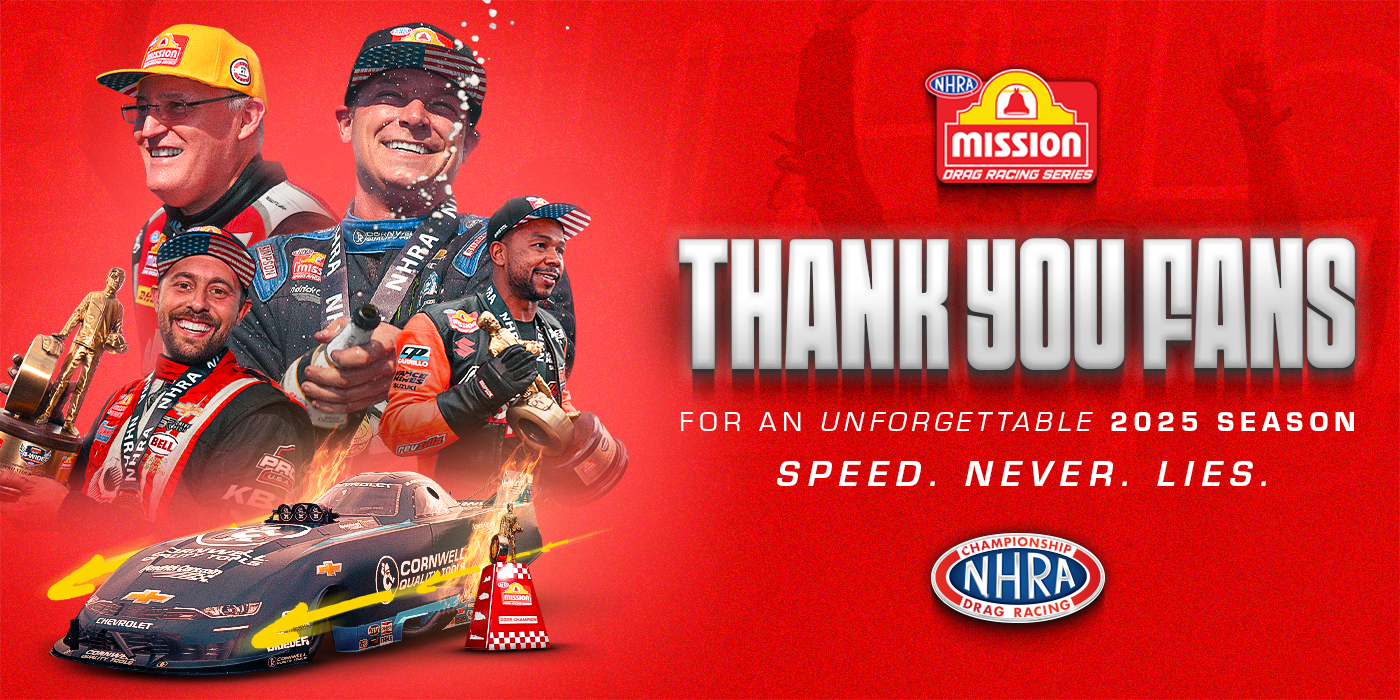

Jake Johnston: Funny Car's "what if?" guy
 |
I don’t remember prolific 1970s Funny Car racer Jake Johnston having a nickname, but if I were to give him one today, it would definitely be “What If?”
What if Johnston hadn’t suffered freak mechanical issues in the final rounds at the 1971 and 1972 World Finals?
What if more Funny Car teams had forsaken their precious automatic transmissions and jumped on the Crowerglide and/or direct-drive system that Johnston and team owner Gene Snow ran on their Funny Cars in the late 1960s?
What if Johnston and Snow had been successful with their experiments with a turbocharged Funny Car running methanol instead of nitro? Or with a car that ran on bottled air that was squeezed under pressure into the engine instead of ground into the manifold through the rotors of a supercharger?
What if, indeed?
Well, for starters, had Johnston won those two final rounds, he would have become a true and unforgotten legend in the sport as Funny Car’s first two-time world champion, three years before Don Prudhomme became famous for being the first to accomplish that feat.
And where might Funny Car performance be today with another couple of years of clutch development under its safety belts or if we hadn’t had to wait until 1988 for direct-drive to become the hot ticket?
How much faster could Funny Cars go without a big ol’ blower and injector sticking out of the windshield that disrupted the airflow? Without a blower, it would also remove the concern of drive-belt failure or backfire. How much cheaper would the cars be if they burned alcohol but still ran in the threes? (And what if, for the sake of this discussion, you could forget for a second that we’d be losing the appeal of that look and the heavenly roar of a nitro-burning, supercharged flopper?)
What if, indeed.
I’ve been a Jake Johnston fan for the longest time. He retired from driving before I came to work at NHRA in 1982, and I had always wanted to interview him about his career, but, despite working my Texas Richard Tharp/Raymond Beadle/Dave Settles connections, the best I could come up with was that he lived in California now. He hadn’t been to the races in more than 20 years because, like a lot of former drivers, he makes a lousy spectator, and he was ever fearful of getting the bug again. I finally caught a break when his I saw that his son, Beau, had some interactions with NHRA’s Twitter account. One thing led to another, and then, voila, last week, I was on the phone with Jake.
I’ve always felt a bit bad for him for what happened to him at the 1971 and 1972 World Finals, as I’m sure the rest of you could empathize with. I mean, geez, two bad breaks robbed him of legendary status, right? He goes from potentially being a god of the class to someone most fans today don’t even know?
Well, guess who isn’t feeling bad for Jake Johnston: Yep, Jake Johnston.
“I don’t look at it that way, I really don’t,” he told me. “Of course I was disappointed at the time, but in racing, you have to keep going. I raced a lot and won a lot of races. You win some, and you lose some. They were both just simple, stupid things that happened. If you’re going to compete, that kind of thing is going to happen. I would have loved to have those trophies under my belt, but I don’t dwell it, that’s for sure.”
He’s a better man than me, for sure, but as you’ll see, that was his nature.

Johnston, right, with Gene Snow in 1969.
|
In the beginning
Johnston got involved in the drag racing scene as a teenager in Fort Worth, Texas. He was enamored with cars and built a ’36 Ford coupe to race. Johnston’s sister was neighbors with Dean Davis, who was a crewmember for Lone Star legend Vance Hunt, and heard about the youngster’s love of cars. One thing led to another, and young Jake soon was invited to join the team at Green Valley Race City (Smithfield, Texas). He graduated from wiping oil pans and tires to hands-on work and earned a reputation as a reliable crewmember always eager to learn more.
By this time, Snow had been running his injected Rambunctious Dart in a variety of classes, with and without nitro, and wanted to build a supercharged car because the Funny Car phenomenon was beginning to take off.
“Gene knew that I’d worked with Vance and that I knew blowers and how to tune the engines,” said Johnston. “I was only 18, but he hired me through a mutual friend and gave me a lot of responsibility for someone that young. Even though Gene wasn’t yet in the oil business, he had a used-car lot that seemed to give him a pretty good income, so we were never wanting for parts.”
Johnston began attending the University of Texas-Arlington, studying engineering, which certainly helped when Snow began to look for new and innovative ways to go faster. While most of their fellow Funny Car racers were still running automatic transmissions, Snow and Johnston began experimenting with the new clutch-based Crowerglide and even direct-drive setups, and the results were impressive: They consistently ran more than 5 mph faster than their competitors in 1969.
“Gene was willing to try a lot of stuff, and while I went through a learning curve with it, I learned a lot,” remembered Johnston. “The automatic transmissions were a real weak link; you had to go through them every week. I don’t think there were even many dragsters running the Crowerglide at the time. When we tried direct-drive, the car would start out slow but would really make up the difference at the top end, and we started winning a lot of races. The lighter we made the car, the better it ran. We had a pretty good advantage before the Lenco [transmissions] came out.”
But Johnston had bigger plans for himself than just tuning.
 |
A driving passion
“I wanted to drive; it was a burning passion I had since I was working for Vance when I was 15,” he said. “I let the word out, and it was Harry Schmidt, who was building the first Blue Max, who gave me my first ride. He knew that I knew how to tune and make a car run fast and was willing to give me the opportunity to drive if I could do that.”
Schmidt began to pair a Don Hardy chassis with a Ramchargers engine (“even though I was a Keith Black kind of guy,” noted Johnston) to create the first Blue Max in late 1969. While the Blue Max was under construction, Johnston continued to work with Snow, who, perhaps seeking to appease his talented young mechanic, gave him more money and his own car, a very narrow Charger built by Dennis Rollain and John Buttera at their Wisconsin shop. “I’m lucky I didn’t get killed in that car,” he laughs today. “It was a very light car; the body was just gel coat because we didn’t want to even add paint. It wasn’t all top-notch equipment, though, and it blew up on me at Irwindale my second race out. The crank broke in half, and the whole clutch and bellhousing came out. I got sideways in the lights and was just about ready to roll over, but fortunately, I had just pulled the chute, and it brought me back straight.”
Johnston and the Blue Max made their debut at the 1970 Winternationals, where they set top speed at 203.61 mph, but not long into their first tour, a highway accident claimed the rig.
“Somebody cut across the grass divider of the interstate and came over into our lane," Johnston remembers. "Harry was driving and had to swerve to miss them, but the race car came completely off the ramp truck and was demolished. We both cried; it was pretty much still a brand-new car, and we were on tour and ready to kick ass. We loaded all the parts and pieces onto the ramp truck and drove it back to Hardy’s, and we worked just about 24/7 and built a new car in just about three weeks. The new chassis, with its narrow roll cage, more closely mimicked the successful Mickey Thompson Mustangs with which Pat Foster was enjoying success and also narrowed the body.”
The car ran solidly that summer but really made its mark that fall at the famed Manufacturers Meet at Orange County Int’l Raceway, where Johnston ran the lowest elapsed time in class history, 6.72, and, in the final, beat Rich Siroonian in “Big John” Mazmanian’s Barracuda on a holeshot, 6.89 to 6.88.
“That really put us on the map,” Johnston remembered.
Seeing this success, Snow — who, ironically, won the world championship that year without Johnston — wooed him back with some big money and a topflight second car.
Reunited and it feels so good
“By this time, Gene had gotten some more sponsors who were willing to pay for that second car to be a good one, and he let me call my shots on my car,” Johnston said. “It worked really well. Those were some of my best years of racing.”
Snow and Johnston fielded a pair of Chargers in 1971 — known as the “ram horn cars” for their distinctive paint scheme — and enjoyed great success on the match race and divisional trails. Johnston and Snow would take off in separate directions to better canvass the country and meet the need for their bookings, with Johnston plying the Midwest and East Coast and Snow challenging all comers out West.
“Very seldom did we cross paths except at the national events,” recalled Johnston. “When we did that first year [1971], I was not allowed to beat him if we did race, but that changed the next year.”

Johnston, near lane, was on his way to victory in the final round of the 1971 World Finals when his car broke its rear end.
|
Dual disappointments
Both Snow and Johnston earned enough points during the 1971 season to be invited to the winner-take-all World Finals in Amarillo, Texas. Snow, representing the Western Conference, was the low qualifier with a 6.98, just ahead of Johnston’s 7.00, and Leroy Goldstein was the low qualifier for the Eastern Conference with a 6.90 in the Candies & Hughes entry.
Snow, Johnston, and Goldstein all got first-round byes because only 17 drivers were qualified for the 32-car field. Although Snow broke the rear end in round two against Phil Castronovo in the Custom Body Charger, Johnston easily moved past Al Marshall and Goldstein around Art Ward. Goldstein then took out Jerry Ruth with a 6.93, and Johnston dispatched Kelly Chadwick with a blistering 6.91.
The expected final-round match between Goldstein and Johnston was thwarted in the semifinals when Goldstein, holding a commanding lead on Castronovo, broke the rear end just before the finish line. Johnston earned another bye in the semifinals and made an easy 7.39 but was the heavy favorite in the final based on his earlier 6.91.
But the same fate that befell Snow and Goldstein before him collected Johnston as well. With a significant jump at the Tree, he was on his way to capturing the event win and the world championship before the rear end broke, and he could only coast to a 9.23 and watch Castronovo win in his first final-round appearance with a 7.15.
“I raced him all the time back East, and he’d never beaten me,” said a chagrined Johnston.

Johnston, far lane, was the top performer at the 1972 World Finals but dropped a cylinder in the final against Larry Fullerton.
|
In 1972, both Snow and Johnston again qualified for the World Finals with their now-Snowman-themed Chargers, but Johnston this year represented the Eastern Conference and Snow the Western. Johnston qualified No. 2 with a 6.79, well behind the surprising 6.61 of Butch Maas in Mart Higginbotham’s Vega, and Snow was well down the list of Western qualifiers.
Snow was upset in round one by Preston Davis in Raymond Godman’s Tennessee Bo Weevil, but Johnston motored easily into his second straight World Finals final with a solid string of e.t.s — 6.79, 6.61, 6.65, and 6.51 — to defeat Kelly Chadwick, “Jungle Jim” Liberman, Leonard Hughes, and an engine-destroying Maas and set himself up again as the prohibitive favorite against Larry Fullerton, whose best e.t. with his and Kevin Doheny’s Trojan Horse Mustang had been a 6.64.
Again, though, the hands of fate decided against Johnston, who dropped a cylinder on the starting line in the final and slipped to a 6.69, well behind the impressive event-best 6.59 registered by Fullerton.
“It just loaded a cylinder on the line, which it would do from time to time.” said Johnston. “We didn’t have dual mags to burn the fuel. Just another bad break.”

Johnston and Snow experimented briefly with a turbocharged Funny Car in 1971. (Steve Reyes photo)
|
 |
New challenges
During their time together, Snow and Johnston also experimented with turbocharged power during the 1971 season. Snow had put together a deal with Hilborn to try to develop the setup using one of his cars. Both he and Johnston drove the car.
“We used to come to California in the winter to build our cars, so he tested the car on the West Coast,” recalled Johnston. “Eventually Gene had to go on tour, so he brought me out; I drove it for maybe a month. We were always trying to do something new and unique and maybe get an edge for a season or two, but the turbo car never did pan out. The guys at Hilborn had done a good job to tailor the turbos to where they were pretty responsive, but it never ran like we hoped it would, and it was pretty quiet. I don’t think the fans would have liked that. Still, all that experience with way-out stuff was a good learning opportunity for me.
In 1973, Johnston was hired by John Keeling and Jerry Clayton to drive their beautiful California Charger Mustang and, on occasion, he also drove their sleek Top Fuel dragster. One of their most memorable outings was the 1973 PDA event at Orange County Int’l Raceway, where Johnston drove both cars and won in the dragster. (That great tale was featured in the column I wrote on Keeling & Clayton last March.)
“I had never really driven a dragster — if you look at the photos, I was still wearing a Funny Car helmet and face mask [as opposed to the traditional full-face helmet used by most Top Fuel drivers], and I had to have Jerry on the starting line to tell me what rpm to leave at. I’d rev it up a bit, look at him, and he’d use hand signals to tell me when I had it right. That was a cool ride; it was fun being out there in the breeze.”

The cold-air car. (Steve Reyes photo)
|
The cold-air car
It was also around this time that Johnston signed on with Cragar on a new project, a Funny Car that ran on bottled air that was pressure-fed into the manifold in place of a supercharger.
“It was perfect for me because the Keeling & Clayton thing was more of a weekend-warrior deal where we didn’t go run a lot of national events, so I could do both,” said Johnston. “I wasn’t going to be on tour, so I decided why not?”
According to the May 1974 issue of Drag Racing USA, the system, developed by Bob Keane, fed a mixture of pure alcohol and cold air into the engine through onboard tanks. The car would be fired, do its burnout, and launch on just the alcohol, but the blown system would kick in seamlessly shortly after the launch. Horsepower was advertised at about 2,000 at 30psi of boost, with the boost being scalable up top 45psi.
“There were a lot of advantages to the system,” declared Johnston. “For starters, you didn’t get the kind of detonation you would on nitro. It was a very cool and sophisticated way of spontaneously getting air to engine.”
Other benefits were reduced engine heat (temperatures at the manifold were -10 degrees, which kept the engine and the oil at “warm”); a fuel cost savings of 80 percent (alcohol over nitro); and, of course, the removal of the potential for devastating blower explosions and/or blower belt breakage.
Although the car eventually ran in the 6.90s, it never came to fruition despite extensive testing.
“We rented Irwindale two to three times a week testing,” remembered Johnston. “It had a lot of potential but was just too complicated for the time, and we had no data logging. We had a 35mm camera mounted on the steering wheel to photograph the gauges, but they always came out blurry. If we had a computer system like is available now to manage that whole system, it would have worked, but it was all mechanical.”

Johnston raced with Joe Pisano for three seasons, highlighted by a runner-up finish (below) at the 1977 Cajun Nationals and a Division 7 championship.
|
 |
Racing with Joe P.
Johnston had no real driving prospects after the cold-air car was shelved, but after veteran handler Sush Matsubara broke a leg (and an arm, in some accounts) in an off-road motorcycle crash, Johnston filled in for him in the Pisano & Matsubara car at the 1975 preseason Winter Classic in Phoenix.
“Joe asked me to fill in for just that one race, but Sush never came back, and Joe was really pleased with what I was doing, so we went on,” recalled Johnston. “We raced together for another couple of years and won the Division 7 championship [in 1977].”
That championship run was not without drama, either. Late in the season, on their way to the Division 7 event at Bonneville Raceway in Salt Lake City, their tow rig blew the radiator outside of Las Vegas.
“We limped the truck to the only shop around, but the guy told us it was going to be a day or two before they could get us a radiator,” Johnston remembered. “Joe got on the phone and found this guy who had a car, and Joe made arrangements for me to drive his car. We called a cab, and Gary Slusser and I took a cab to the airport and flew to Salt Lake City.”
The guy was Rich McMichaels, a little-known racer from Salt Lake City, who owned the Pink Chablis Vega.
“I don’t remember the details — if he was new to the car or hadn’t run it much — but it had never even been in the sixes before,” said Johnston. “We put our tune-up in it and got it qualified and got some points and even ran in the sixes [6.97]. We lost in the first round, but we still won the division championship.”
Other highlights for the team were a runner-up, to Johnny White, at the Cajun Nationals in 1977 and a career-high eighth-place finish for Johnston in 1976. (It’s rather ironic that Johnston’s three runner-ups were to drivers — Castronovo, Fullerton, and White — who won their only national event against him.)

At the 1972 National Challenge in Tulsa, suffered a brief but intense fire in round one. “We burned a piston and the engine laid over in the lights,” he recalled. “I don’t remember if it put a rod out or not, but it got going pretty good. It burned all of the stitching out of my gloves; when I finally got out, I didn’t even have to pull them off; they just fell off.”
|
Hanging it up
Johnston got out of the game in 1978 and was replaced in the Pisano car by Pat Foster.
“I’d gotten married and was expecting a son and had started a business,” he explained. “I just felt it was time. I was always a hired driver, never owned my own car. Maybe if I did, I would have stayed longer, but being a hired guy was always up and down and then got down to just being a weekend-warrior thing, not even on tour. I looked at the future, and there were no big sponsorships out there. It seemed like maybe it was just going to be a dead end for me.”
Johnston’s business, a manufacturer for aerospace and defense with customers such as Boeing and Northrop, was a huge success, and he retired last September and lives in Anaheim Hills, Calif. Just don’t expect to see him at a drag race anytime soon.
“I haven’t even picked up a drag racing publication in probably 20 years and haven’t really even been in touch with most of the people I raced with since then,” he admitted. “I haven’t been to a race since I left. I’m weak. It’s so addictive. I’d probably want to come back again.”
It’s a refrain I’ve heard many times, that old drivers make lousy spectators, but Johnston promised to call me if he ever changes his mind. It would be great for him to be out among today’s heroes, sharing some of those great “what if” stories and reminding everyone of how it used to be. Me, I’m just honored to share his story.





